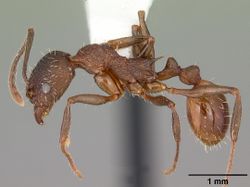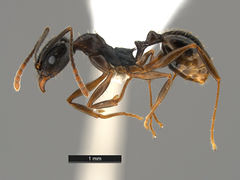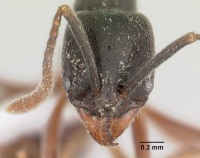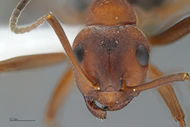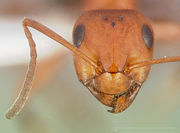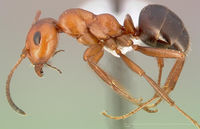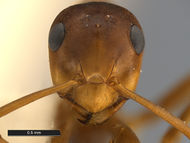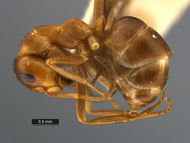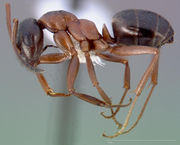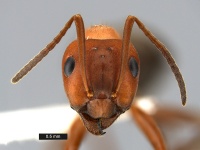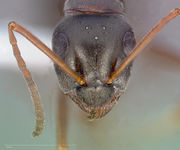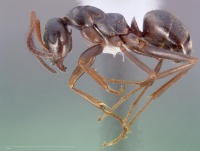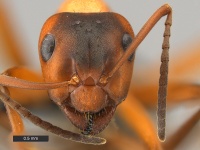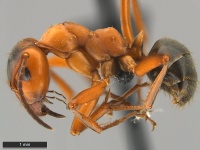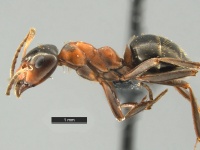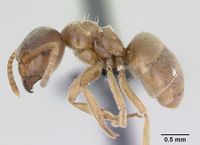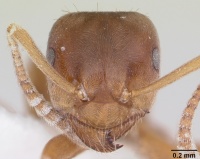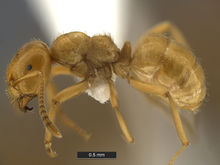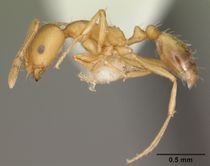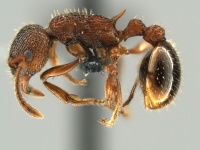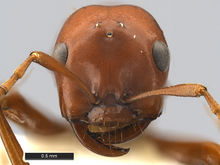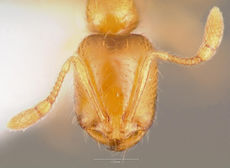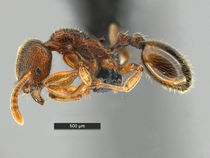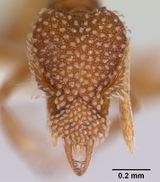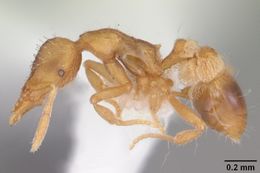New England Ant Identification
New England encompasses the states of Maine, Vermont, New Hampshire, Massachusetts, Connecticut and Rhode Island.
There is a list of New England Ant Species
The keys below are based on the 2012 book A Field Guide to the Ants of New England
.
Aphaenogaster
6 species
1
- The first gastral tergite has long, distinct lines or grooves (striae) that radiate in a sunburst pattern from the postpetiole; head and mesosoma coaresly scultpured with dense, anastomosing ridges (rugae); the propodeal spines are very long – at least as long as the distance between their tips . . . . . Aphaenogaster mariae
- First gastral tergite lacks striae; sculpturing on head and mesosoma fine; the propodeal spines normally are not longer than the distance between their tips, but if they are, the mesosoma and gaster are hairless . . . . . 2
2 (1)
- The cheeks, as well as the dorsum of the mesosoma and gaster are hairless; the propodeal spines are very long – at least as long as the distance between their tips . . . . . Aphaenogaster tennesseensis
- Cheeks, mesosoma, and gaster with many erect hairs; propodeal spines normally not longer than the distance between their tips . . . . . 3
3 (2)
- Base of antennal scape with a wide, thick lobe extending about 1/4 of the length of the scape . . . . . Aphaenogaster treatae
- Base of antennal scape without a lobe . . . . . 4
4 (3)
- The last four segments of the antennae are the same color as the remaining segments; the propodeal spines are short – not more than ½ the length of the propodeal declivity (rear-sloping face) – and pointed upward; the top (peak) of the mesonotum not higher than the top of the pronotum . . . . . Aphaenogaster rudis a species complex
- The last four segments of the antenna are ligher in color or paler than the remaining segments; propodeal spines at least 2/3 the length of the propodeal declivity and pointed either upwards or towards the rear; top (peak) of the mesonotum as high or higher than the top of the pronotum . . . . . 5
5 (4)
- Propodeal spines long – at least as long as the propodeal declivity – and pointing upwards; color reddish-brown . . . . . Aphaenogaster fulva
- Propodeal spines shorter – approximately 2/3 the length of the propodeal declivity – and pointing towards the rear; color dark brown or blackish-brown . . . . . Aphaenogaster picea a species complex
Brachymyrmex
Brachyponera
Camponotus
8 species
Key to Camponotus of New England
Crematogaster
2 species
- No erect hairs on mesosoma except for 1-2 pairs of erect hairs on the corners of the pronotum . . . . . Crematogaster cerasi
- Many (8-20) short hairs on the pronotum and scattered elsewhere on the mesosoma . . . . . Crematogaster lineolata
Dolichoderus
4 species
There are only 4 species of Dolichoderus in all of North America. All of these species have a range that includes New England.
Key to North American Dolichoderus Species
Forelius
Formica
31 species
- Formica cf. fossaceps - an undescribed species
- Formica creightoni
- Formica dakotensis - occurs in areas around New England and is likely to be found here
- Formica dirksi - only known from type specimens
- Formica morsei - only known from type specimens
Formicoxenus
Harpagoxenus
Hypoponera
- Hypoponera punctatissima - a non-native species
Lasius
17 species
- Lasius cf. niger - this may be an undescribed species
- Lasius cf. umbratus - an undescribed species
- Lasius claviger
- Lasius murphyi - occurs in areas around New England and is likely to be found here
- Lasius plumopilosus - occurs in areas around New England and is likely to be found here
Leptothorax
5 species
1
- Ant with numerous erect hairs on the antennal scapes and tibiae; a species of boreal bogs; occurs in areas north of New England and may also be found here . . . . . Leptothorax sphagnicola
- Erect hairs absent on antennal scapes or tibiae; wooded or open habitats, rarely bogs . . . . . 2
2 (1)
- Clypeus deeply notched; queens very small; most common in boreal forests, but extending into boreal-temperate transition zone, especially in stands dominated by Jack Pine (Pinus banksiana) . . . . . Leptothorax retractus
- Clypeus not notched . . . . . 3
3 (2)
- Six teeth clearly visible on mandibles of workers and queens; lower surface of the post-petiole with or without a prominent tooth . . . . . 4
- Only one tooth (an apical one) present on mandible of the queens; lower surface of the post-petiole with a prominent tooth; any workers (with six teeth) that are present in the colony are those of this species’ host (Leptothorax sp. AF-can) . . . . . Leptothorax wilsoni
4 (3)
- Ant dark-brown to black, hairs on mesosoma short (< 0.04 mm); no anterior process visible on lower surface of post-petiole; a widespread species in northeastern woodlands . . . . . Leptothorax sp. AF-can - an undescribed species
- Ant light-brown to brown. Hairs on mesosoma long (> 0.07 mm); anterior process visible on lower surface of post-petiole; relatively uncommon species of dry open or disturbed woodlands . . . . . Leptothorax sp. AF-erg - an undescribed species
Monomorium
4 species
1
- Ant concolorous, dark green to black . . . . . 2
- Ant bi-colored, or if concolorous, then yellow-to-light brown with a black-tipped gaster . . . . . 3
2
- Length of the dorsal surface of the propodeum is shorter than the length of the sloping, posterior surface of the propodeum (the declivity); body black; widespread throughout New England . . . . . Monomorium emarginatum
- Length of the dorsal surface of the propodeum is longer than the length of the declivity; body dark green to black; nests only in pure sandy soils . . . . . Monomorium viridum
3
- Ant uniformly yellow-red or light brown, except for the gaster, which is at least dark brown or black at the tip, but may be entierely dark brown or black . . . . . Monomorium pharaonis
- A bi-colored ant with a dark head and gaster and a light brown mesosoma . . . . . Monomorium floricola
Myrmecina
- Myrmecina new species - an inquiline social parasite of Myrmecina americana
- Myrmecina americana
Myrmica
21 species
- Myrmica lampra - occurs in areas north of New England and may also be found here
- Myrmica quebecensis - occurs in areas north of New England and may also be found here
- Myrmica rubra - a non-native species
- Myrmica scabrinodis - a non-native species
- Myrmica sp. AF-eva - an undescribed species
- Myrmica sp. AF-ine - an undescribed species
- Myrmica sp. AF-scu - an undescribed species
- Myrmica sp. AF-smi - an undescribed species
- Myrmica sp. AF-sub - an undescribed species
Nylanderia
3 species
1
- Antennal scapes without erect hairs; workers lack ocelli; a native, widespread species . . . . . Nylanderia parvula
- Antennal scapes with at least one erect hair, workers with many more hairs; workers, if present, have small ocelli 2
2
- Antennal scapes of workers and queens with many erect hairs; workers with small ocelli; an introduced species currently recorded in New England only from inside heated buildings and greenhouses . . . . . Nylanderia flavipes
- Colonies consisting of queens and males relying on host workers of N. parvula; queens have at least one erect hair on at least one of the antennal scapes, but host workers lack erect hairs on their antennal scapes; queens < 2 mm long . . . . . Nylanderia deceptrix
Paratrechina
- Paratrechina longicornis - a non-native species
Pheidole
2 species
- In dorsal view, the post-petiole of the major workers is more-or-less diamond-shaped with sharp corners; ant brown; our only native New England species . . . . . Pheidole pilifera
- In dorsal view, post-petiole of the majors is more-or-less round or oval-shaped, lacking sharp corners; ant yellow; a tropical species encountered in New England only indoors . . . . . Pheidole flavens
Polyergus
3 species
1
- The workers have 20 or more, coarse, dark, erect hairs on the rear margin of their heads; the host is Formica dolosa; this largest of our Polyergus species has workers generally > 6.5 mm long . . . . . Polyergus cf. longicornis - an undescribed species
- Workers with < 10 erect hairs on the rear margin of the head; enslaves other Formica species, but never F. dolosa. Workers generally < 6 mm long . . . . . 2
2
- Workers with at least 5, and usually 10 erect hairs on the rear margin of the head; enslaves F. incerta; body very shiny, head usually shiny . . . . . Polyergus lucidus
- Workers usually with no erect hairs, but never more than 5 erect hairs, on the rear margin of the head; enslaves Formica pallidefulva; body and head with a matte (not shiny) appearance; occurs in areas east of New England and may also be found here . . . . . Polyergus montivagus
Ponera
Prenolepis
Proceratium
3 species
1
- Second gastral segment enlarged; subsequent segments located below and near the front of the second segment; anterior border of the clypeus slightly convex with a projecting median lobe; petiole low and rounded when viewed from above . . . . . Proceratium pergandei
- Third and later gastral segments located below but near the back of the second segment; anterior border of clypeus without a median lobe; petiole relatively high and rectangular when viewed from above . . . . . 2
2
- Petiole thick in profile (the crest is almost as thick as the base); frontal area ¼ as wide as head; frontal carinae diverge towards the top of the head; erect hairs on gaster short and sparse . . . . . Proceratium crassicorne
- Petiole slender in profile (crest distinctly thinner than base); frontal area >¼ as wide as head; frontal carinae strongly divergent towards the bottom of the head. Erect hairs on gaster long and dense. . . . . . Proceratium silaceum
Solenopsis
2 species
- In dorsal view, the post-petiole is noticeably wider than the petiole; in profile view, the summit of the petiole is relatively narrow; the ant is yellow-brown and nests in a wide variety of soils, but never in pure sand . . . . . Solenopsis molesta
- In dorsal view, the post-petiole is approximately as wide as the petiole; in profile view, the summit of the petiole is relatively broad; a lemon-yellow ant that nests only in pure sand . . . . . Solenopsis cf. texana
Stenamma
4 species
1
- Compound eye with 5 – 12 facets (ommatidia) in its widest diameter, and > 20 facets total; relatively large for a Stenamma (total length 2.75 – 4.0mm) . . . . . Stenamma brevicorne
- Compound eye with 3 – 6 facets in its widest diameter and < 15 facets total; a smaller species (total length 2 – 3.5mm) . . . . . 2
2
- Compound eyes very small, consisting of 3 – 6 facets; mesosoma sculptured with pronounced punctures, giving the ant a matte appearance . . . . . Stenamma schmittii
- Compound eyes larger, consisting of 8 – 15 facets . . . . . 3
3
- Compound eye with 4 – 5 small facets across its widest diameter; total length 2.7 – 3.5mm; conspicuous sculpturing on the pronotum, but the promesonotum and the post-petiole are usually smooth and shiny; common north of Massachusetts . . . . . Stenamma diecki
- Compound eye with 5 – 6 coarse facets across its widest diameter; total length 2.3 – 2.7mm; sculpturing on the mesosoma is faint, and extends to the promesonotum and post-petiole (i.e., not smooth and shiny); more common in Massachusetts and southern New England . . . . . Stenamma impar
Stigmatomma
Strumigenys
3 species
1
- In full face view, mandibles elongate, narrow, and with teeth only on the anterior third to half of the mandibles; the first (basal) and third mandibular teeth are sharp, but the second mandibular tooth is broad and blunt . . . . . Strumigenys pergandei
- In full face view, mandibles triangular-to-elongate, with teeth along the entire surface except for a small gap between the clypeus and the basal tooth . . . . . 2
2
- The hairs on the clypeal margins, both lateral and anterior, curve towards the mandibles; paired erect hairs on dorsum, mesonotum, and first gastral segment are long, straight, and sharp; antennal hairs curved; antennal hairs closest to the base of the scape have broad, rounded (spatulate) ends, those further up the scape are not blunt-tipped . . . . . Strumigenys metazytes
- Hairs on the lateral clypeal margins curve towards the mandibles, but those on the anterior margin curve away from the mandibles; paired erect hairs on dorsum, mesonotum, and first gastral segment are short and whip-like (flagellate); antennal hairs curved and all are spatulate . . . . . Strumigenys pulchella
Tapinoma
3 species
1
- Workers tiny, < 1.5 mm long; head and mesosoma brown, gaster and legs milky white; a tropical species that is a rare inhabitant of greenhouses and other heated structures in New England . . . . . Tapinoma melanocephalum
- Workers larger, 2.5 – 3.5 mm long; ants uniformly brown . . . . . 2
2
- Queens generally large, at least 5.5 mm; queens and males produced and fly in mid-summer (late July to early August) . . . . . Tapinoma sessile
- Queens much smaller, 2.0 – 2.5 mm long; queens and males produced and fly in late summer (mid-August to late September); a rare inquiline social parasite of T. sessile. Note: workers are not produed by this species – if workers are observed in the colony, they are the workers of the host, T. sessile . . . . . *Tapinoma new species
Temnothorax
6 species
One species, Temnothorax americanus was not included in this key as in 2012 it was considered to be Protomognathus americanus. This species is a social parasite of a number of Temnothorax species that occur in New England.
1
- The post-petiole is massive – its width is 1.5X the width of the petiole; antennae with 12 segments; roughly sculptured with rugae on head, mesosoma, petiole, and post-petiole; gaster smooth and glossy; color dark brown/black . . . . . Temnothorax texanus
- Post-petiole < 1.25X width of the petiole; antennae with 11 segments; color black or orange-yellow . . . . . 2
2
- Head covered with fine lines (striae); propodeal spines short, length < ½ the distance between their bases; color normally dark brown . . . . . Temnothorax schaumii
- Head smooth or with net-like (reticulate) sculpturing, but not finely striated; propodeal spines longer than ½ the distance between their bases; color yellowish-orange to dark brown or black . . . . . 3
3
- A dark brown to black ant; dorsum of head smooth, shining; propodeal spines very long, pointing nearly straight back . . . . . Temnothorax longispinosus
- A yellowish-brown ant; top of head sculptured . . . . . 4
4
- Propodeal spines well-separated at base; each spine shorter than the distance separating their bases; gaster uniform in color; post-petiole notably broader than long . . . . . Temnothorax ambiguus
- Propodeal spines close together at base; each spine much longer than the distance separating their bases; gaster with a dark splotch or stripe; post-petiole nearly square (subquadrate), i.e., not significantly broader than long . . . . . Temnothorax curvispinosus
Tetramorium
- Tetramorium atratulum - a non-native species
- Tetramorium immigrans - a non-native species
Tetramorium immigrans, the sidewalk ant, is a common ant in urban and suburban areas. Tetramorium atratulum is a workerless inquiline that parasites T. immigrans. The parasite has only been collected a handful of times in North America.

